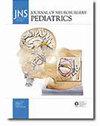Indirect revascularization for pediatric moyamoya disease.
IF 2.1
3区 医学
Q3 CLINICAL NEUROLOGY
引用次数: 0
Abstract
OBJECTIVE Indirect revascularization is a common and effective treatment for pediatric moyamoya disease. However, in several cases postoperative angiogenesis is not sufficient. It is not fully understood which factors are involved in the development of postoperative collateral circulation. In this study, the authors aimed to elucidate the factors related to postoperative angiogenesis in indirect revascularization. METHODS Among the patients who underwent indirect revascularization for moyamoya disease from January 2015 to December 2022, those whose angiogenesis was evaluated using angiography were included. Age, onset symptoms, comorbidities, preoperative imaging findings, surgical details, perioperative complications, postoperative imaging findings, and modified Rankin Scale (mRS) score at the last outpatient visit were retrospectively examined. RESULTS Ninety cases (53 patients; 37 bilateral, 16 unilateral) were included. Sixty-eight cases (75.6%) were symptomatic. The mean age at surgery was 7.9 years, and the mean postoperative follow-up duration was 48.5 months. Frontotemporal encephalo-duro-arterio-synangiosis (EDAS) was performed in all cases, and simultaneous frontal encephalo-galeo-synangiosis (EGS) was performed in 34 cases. Postoperative angiography revealed insufficient angiogenesis in 14 of 90 cases (15.6%) after frontotemporal EDAS and in 8 of 34 cases (23.5%) after frontal EGS. A high degree of ivy sign depicted on preoperative MRI was found to be significantly correlated with good angiogenesis after both surgical procedures (p = 0.00030 for EDAS and p = 0.0039 for frontal EGS). In addition, an advanced preoperative Suzuki stage was significantly correlated with good postoperative angiogenesis after EDAS (p = 0.00040). Good angiogenesis was significantly correlated with postoperative improvement of the ivy sign in both procedures (p = 0.0005 in EDAS and p = 0.030 in frontal EGS) as well as correlated with a better mRS score at long-term follow-up after EDAS (p = 0.018). CONCLUSIONS Preoperative ivy sign and Suzuki classification are related to the degree of angiogenesis achieved after indirect revascularization for pediatric moyamoya disease.小儿 moyamoya 病的间接血管再造术。
目的间接血管重建术是治疗小儿莫亚莫亚病的一种常见而有效的方法。然而,在一些病例中,术后血管生成并不充分。目前还不完全清楚哪些因素参与了术后侧支循环的形成。在这项研究中,作者旨在阐明间接血管再通术中术后血管生成的相关因素。方法在2015年1月至2022年12月期间因moyamoya病接受间接血管再通术的患者中,纳入了使用血管造影术评估血管生成的患者。回顾性研究了患者的年龄、发病症状、合并症、术前影像学检查结果、手术细节、围手术期并发症、术后影像学检查结果以及最后一次门诊时的改良Rankin量表(mRS)评分。68例(75.6%)患者无症状。手术时的平均年龄为 7.9 岁,术后平均随访时间为 48.5 个月。所有病例均进行了额颞叶脑-双动脉-同步血管成形术(EDAS),34 例病例同时进行了额叶脑-神经-同步血管成形术(EGS)。术后血管造影显示,90 例患者中有 14 例(15.6%)在额颞部 EDAS 术后血管生成不足,34 例患者中有 8 例(23.5%)在额叶 EGS 术后血管生成不足。研究发现,术前核磁共振成像显示的高度常春藤征与两种手术方法后的良好血管生成显著相关(EDAS 为 p = 0.00030,额叶 EGS 为 p = 0.0039)。此外,术前铃木分期晚期与 EDAS 术后良好的血管生成显著相关(p = 0.00040)。在两种手术中,良好的血管生成与术后常春藤征的改善明显相关(EDAS 为 p = 0.0005,额叶 EGS 为 p = 0.030),并且与 EDAS 术后长期随访时较好的 mRS 评分相关(p = 0.018)。
本文章由计算机程序翻译,如有差异,请以英文原文为准。
求助全文
约1分钟内获得全文
求助全文
来源期刊

Journal of neurosurgery. Pediatrics
医学-临床神经学
CiteScore
3.40
自引率
10.50%
发文量
307
审稿时长
2 months
期刊介绍:
Information not localiced
 求助内容:
求助内容: 应助结果提醒方式:
应助结果提醒方式:


